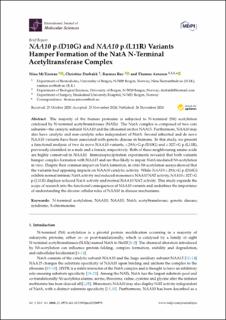| dc.contributor.author | Mc Tiernan, Nina | |
| dc.contributor.author | Darbakk, Christine | |
| dc.contributor.author | Ree, Rasmus | |
| dc.contributor.author | Arnesen, Thomas | |
| dc.date.accessioned | 2021-07-09T07:34:28Z | |
| dc.date.available | 2021-07-09T07:34:28Z | |
| dc.date.created | 2021-01-17T21:15:17Z | |
| dc.date.issued | 2020 | |
| dc.identifier.issn | 1422-0067 | |
| dc.identifier.uri | https://hdl.handle.net/11250/2763997 | |
| dc.description.abstract | The majority of the human proteome is subjected to N-terminal (Nt) acetylation catalysed by N-terminal acetyltransferases (NATs). The NatA complex is composed of two core subunits—the catalytic subunit NAA10 and the ribosomal anchor NAA15. Furthermore, NAA10 may also have catalytic and non-catalytic roles independent of NatA. Several inherited and de novo NAA10 variants have been associated with genetic disease in humans. In this study, we present a functional analysis of two de novo NAA10 variants, c.29A>G p.(D10G) and c.32T>G p.(L11R), previously identified in a male and a female, respectively. Both of these neighbouring amino acids are highly conserved in NAA10. Immunoprecipitation experiments revealed that both variants hamper complex formation with NAA15 and are thus likely to impair NatA-mediated Nt-acetylation in vivo. Despite their common impact on NatA formation, in vitro Nt-acetylation assays showed that the variants had opposing impacts on NAA10 catalytic activity. While NAA10 c.29A>G p.(D10G) exhibits normal intrinsic NatA activity and reduced monomeric NAA10 NAT activity, NAA10 c.32T>G p.(L11R) displays reduced NatA activity and normal NAA10 NAT activity. This study expands the scope of research into the functional consequences of NAA10 variants and underlines the importance of understanding the diverse cellular roles of NAA10 in disease mechanisms. | en_US |
| dc.language.iso | eng | en_US |
| dc.publisher | MDPI | en_US |
| dc.rights | Navngivelse 4.0 Internasjonal | * |
| dc.rights.uri | http://creativecommons.org/licenses/by/4.0/deed.no | * |
| dc.title | NAA10 p.(D10G) and NAA10 p.(L11R) variants hamper formation of the NatA N-terminal acetyltransferase complex | en_US |
| dc.type | Journal article | en_US |
| dc.type | Peer reviewed | en_US |
| dc.description.version | publishedVersion | en_US |
| dc.rights.holder | Copyright the authors | en_US |
| dc.source.articlenumber | 8973 | en_US |
| cristin.ispublished | true | |
| cristin.fulltext | original | |
| cristin.qualitycode | 1 | |
| dc.identifier.doi | 10.3390/ijms21238973 | |
| dc.identifier.cristin | 1872730 | |
| dc.source.journal | International Journal of Molecular Sciences | en_US |
| dc.relation.project | Helse Vest RHF: F-12540-D11382 | en_US |
| dc.relation.project | Kreftforeningen: 171752—PR-2009-0222 | en_US |
| dc.relation.project | Helse Vest RHF: 912176 | en_US |
| dc.relation.project | Norges forskningsråd: 249843 | en_US |
| dc.identifier.citation | International Journal of Molecular Sciences. 2020, 21 (23), 8973. | en_US |
| dc.source.volume | 21 | en_US |
| dc.source.issue | 23 | en_US |

